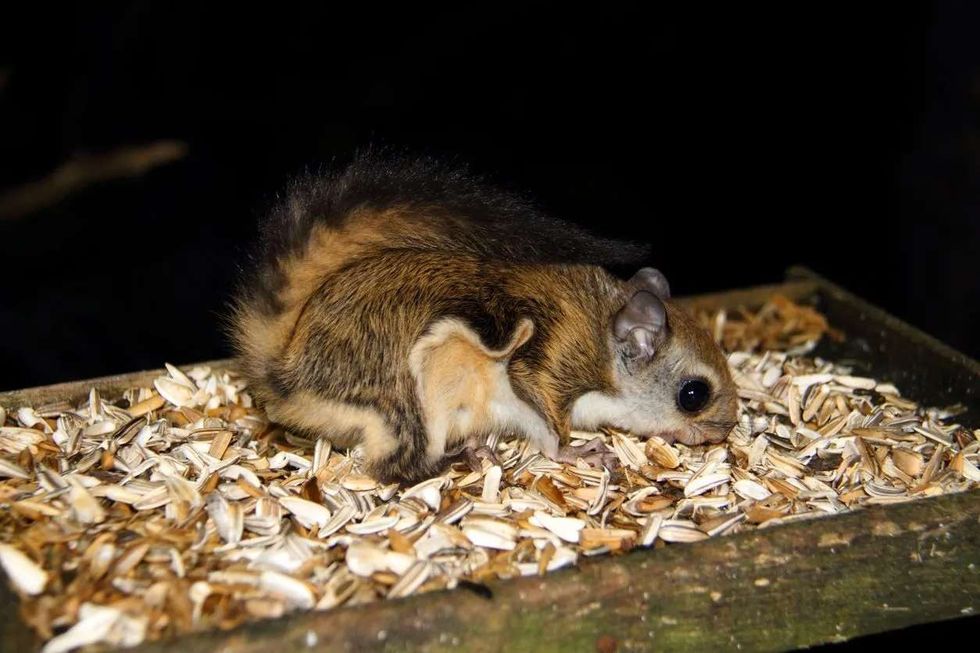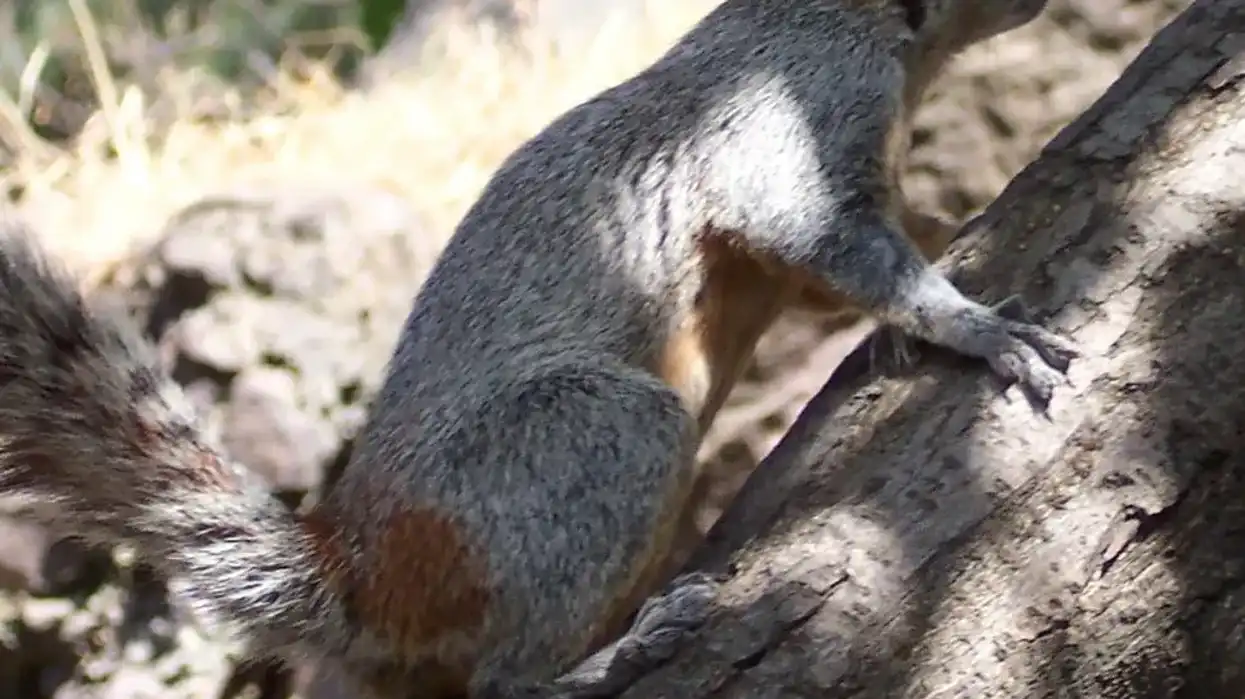When you look at a Japanese flying squirrel, you might think it has emerged straight out from a cartoon show! Today, let's visit the Honshu and Kyushu islands of Japan to learn about this amazing being.
The species' scientific name is Pteromys momonga, and it is one among two species of the genus Pteromys. They are arboreal animals that are active during the night. During their nighttime adventures, they satiate their hunger with all types of seeds, barks, fruits, and flowers.
Their population is abundant and continues to grow in Japan. These animals have no known threat and are classified as Least Concern currently. If you like reading through this content, do indulge in reading about our marsupial and short-beaked echidna facts too right here!
Japanese Dwarf Flying Squirrel Interesting Facts
What type of animal is a Japanese dwarf flying squirrel?
The Japanese dwarf flying squirrel (Pteromys momonga) is a rodent species native to Japan. Surprisingly, the squirrel does not actually fly; instead, it glides from tree to tree with the help of a special membrane called a patagium that it has on either side of its body.
This species is often confused with Siberian flying squirrels, however, Siberian flying squirrels have gray coloration as opposed to brown.
What class of animal does a Japanese dwarf flying squirrel belong to?
The flying squirrel belongs to the Mammalia class. It is one among two species of Old World flying squirrels.
How many Japanese dwarf flying squirrels are there in the world?
An exact count of members of this species is unavailable. Having said that, their population is abundant, and the IUCN has stated that this animal has no known threat currently. The species is flourishing and is expanding its lineage in Japan.
Where does a Japanese dwarf flying squirrel live?
This animal is native to the Honshu and Kyushu islands of Japan. They live in boreal evergreen forests and sub-alpine forests as their bodies are best suited to a temperate climate. They often locate their nests on pine or spruce trees, giving them easy access to food (seeds).
What is a Japanese dwarf flying squirrel's habitat?
The habitat of these animals is arboreal, meaning that they eat, sleep, mate, and play on trees. They glide from tree to tree to collect food or escape predators. Their nests are found at intersections of tree trunks and branches.
These animals are not only found on trees at almost all times, but they are also strictly nocturnal. During sunlight hours, they are seen resting in tree holes or in their nests. At night, they move around looking for food or mates.
Who do Japanese dwarf flying squirrels live with?
This rodent is a social being, hanging around with fellow citizens of its species. Several individuals of the same sex can be found living together, but this changes during the mating season, where we see both sexes occupying the same tree.
How long does a Japanese dwarf flying squirrel live?
The Japanese dwarf flying squirrel (Pteromys momonga) lives for between four and five years in the wild. However, they can live longer in captivity with adequate care. Their lifespan can be 10-15 years in captivity.
How do they reproduce?
Squirrels reproduce sexually, but there is no concrete information about the mating systems of flying squirrels (Pteromys momonga). They partake in seasonal breeding, usually twice a year, from May to July.
The gestation period lasts for four weeks and results in a female Japanese flying squirrel giving birth to between two and three young ones.
The babies are born with no fur, and the mothers are very protective of their offspring and nurse them for the first six weeks. There is no information about the father's role in parental care.
What is their conservation status?
According to the IUCN, this species is not endangered and poses no significant threats; hence it is classified as Least Concern.
Japanese Dwarf Flying Squirrel Fun Facts
What do Japanese dwarf flying squirrels look like?
They are tiny rodents with brown-white fur. This coloration helps them camouflage and protect themselves from predators. Their body length is approximately equal to their tail length. This tail length helps in maintaining their balance as the rodent glides from tree to tree throughout the night. The gliding membrane (patagium) stretches from the animal's wrists to its ankles.
How cute are they?
This species can undoubtedly be described as one of the most adorable species in Japan. Their miniature claws, cute whiskers, and deep black eyes make them super cute. Because of their cute appearance, both Japanese flying squirrels and Siberian flying squirrels are used as the design on Japan's metro cards!
How do they communicate?
These animals are assumed to communicate through vocalizations and chattering sounds. Also, mothers and young ones use tactile communication such as body language and touching. This type of communication is common in mammals, especially when a mother nurses her child.
How big is a Japanese dwarf flying squirrel?
The squirrel (Pteromys momonga) is 5.5-7.8 in (14-20 cm) long. It has a tail almost as long as its body at 3.9-5.5 in (10-14 cm.). The Japanese giant flying squirrel is about three times as long as the Japanese dwarf flying squirrel.
How fast can a Japanese dwarf flying squirrel move?
The exact speed of the animal is unknown, but this rodent can glide distances of almost 328 ft (100 m) at a time. In addition, it is known for its agility and its ability to make sharp turns.
How much does a Japanese dwarf flying squirrel weigh?
This species (Pteromys momonga) weighs about 0.3-0.4 lb (150-220 g). Its weight is relatively low when compared with other flying squirrels like the black flying squirrel.
What are their male and female names of the species?
A male squirrel is called a 'buck', and a female squirrel is called a 'doe'.
What would you call a baby Japanese dwarf flying squirrel?
A baby Japanese flying squirrel is referred to as a 'pup', 'kitten', or 'kit'. As they are mammals, they are frequently addressed as 'young' too.
What do they eat?
Unlike most flying squirrels, the Japanese squirrel is a herbivore. Their diet includes pine seeds, nuts, leaves, fruits, flowers, buds, and bark. Occasionally, they feed on tiny insects to fulfill their nutritional requirements. The animal facilitates seed dispersion by consuming pine seeds, thereby helping the pine trees' population to grow.
Are they poisonous?
This species of flying squirrels is not poisonous, but they can be carriers of infectious diseases. This disease can spread to humans and can be hazardous in this way.
Would they make a good pet?
They are wild animals who love open spaces so are seldom seen as pets. If you plan on having one as a pet, you should know that they require a lot of care, especially during the early months. After some time, they are known to show affection towards the owner.
Did you know...
Species of flying squirrels are believed to have emerged 18-20 million years ago!
Can you own a Japanese dwarf flying squirrel?
Information about owning this species varies from country to country. Although they are seen as loyal pets in some households, it is illegal to keep them in captivity in many other countries.
A few places allow you to acquire one after a permit. Sadly, sometimes humans exploit the species for its soft fur, and the international pet trade can harm this species.
How active are they?
The species is highly active, but only during the nighttime. They complete all their activities (feeding, playing, and mating) in the dusk. These squirrels also use their ability to glide from tree to tree to avoid predators like owls, cats, weasels, and coyotes.
Here at Kidadl, we have carefully created lots of interesting family-friendly animal facts for everyone to discover! Learn more about some other rodents from our porcupine facts and dormouse facts pages.
You can even occupy yourself at home by coloring in one of our free printable Japanese dwarf flying squirrel coloring pages.










